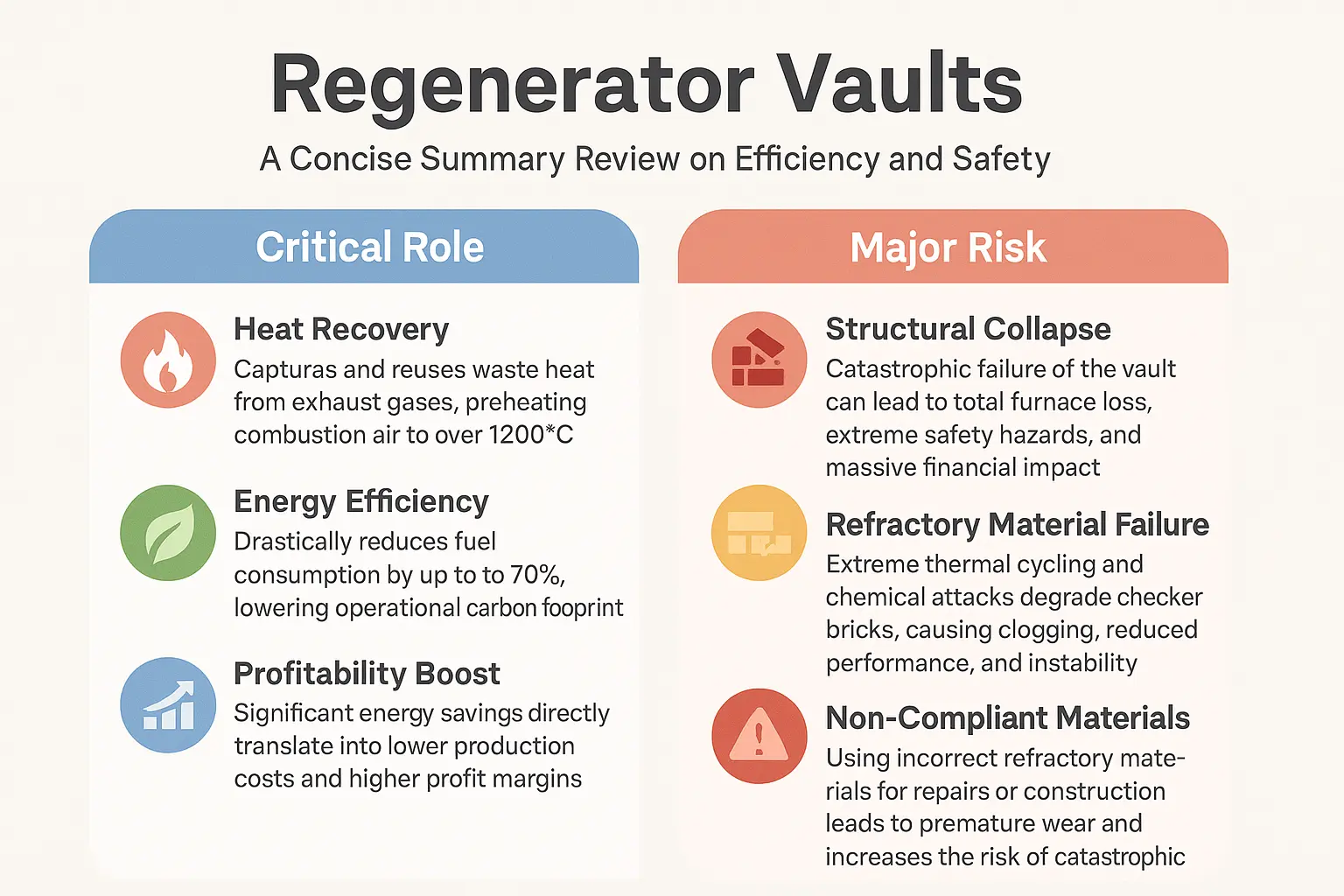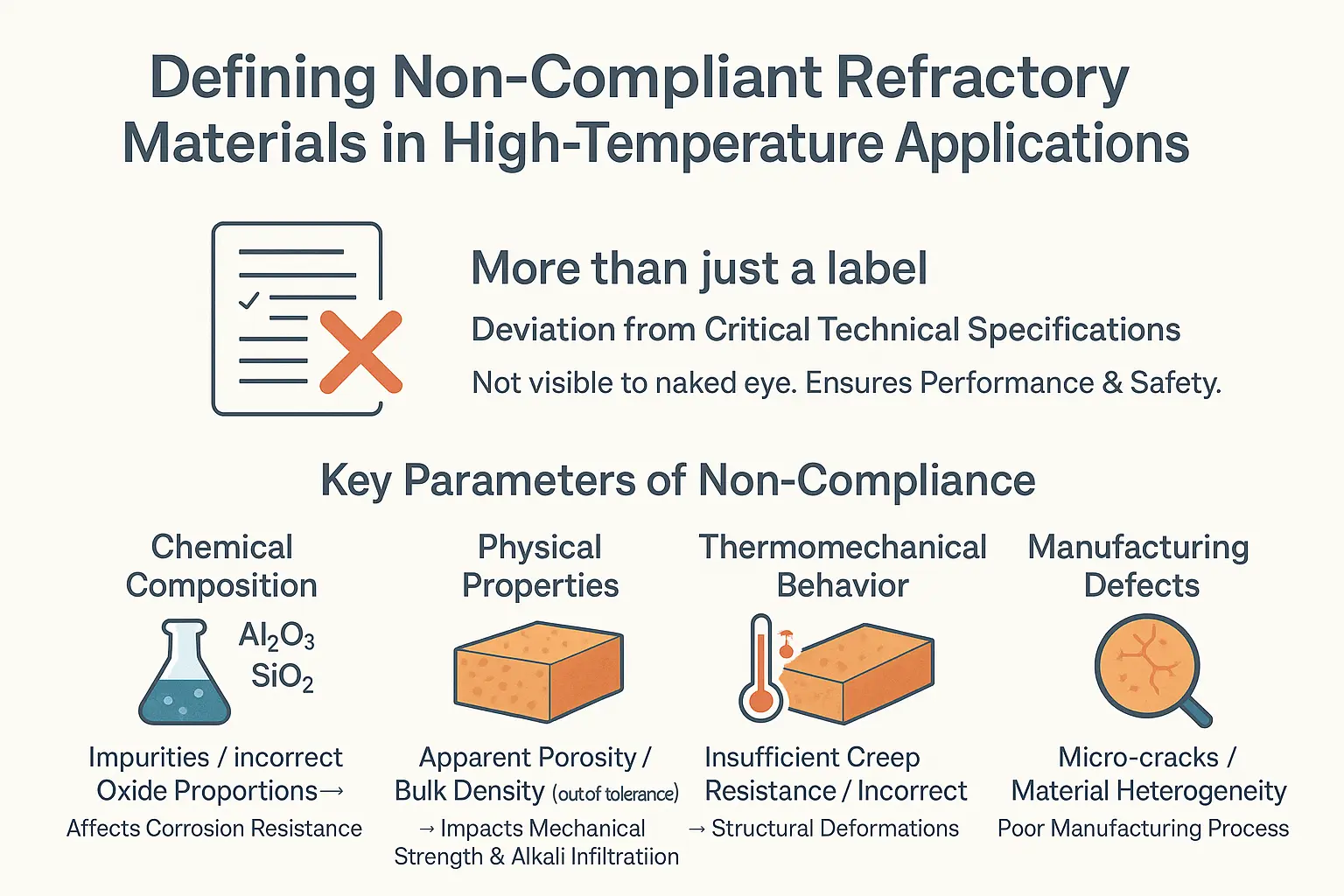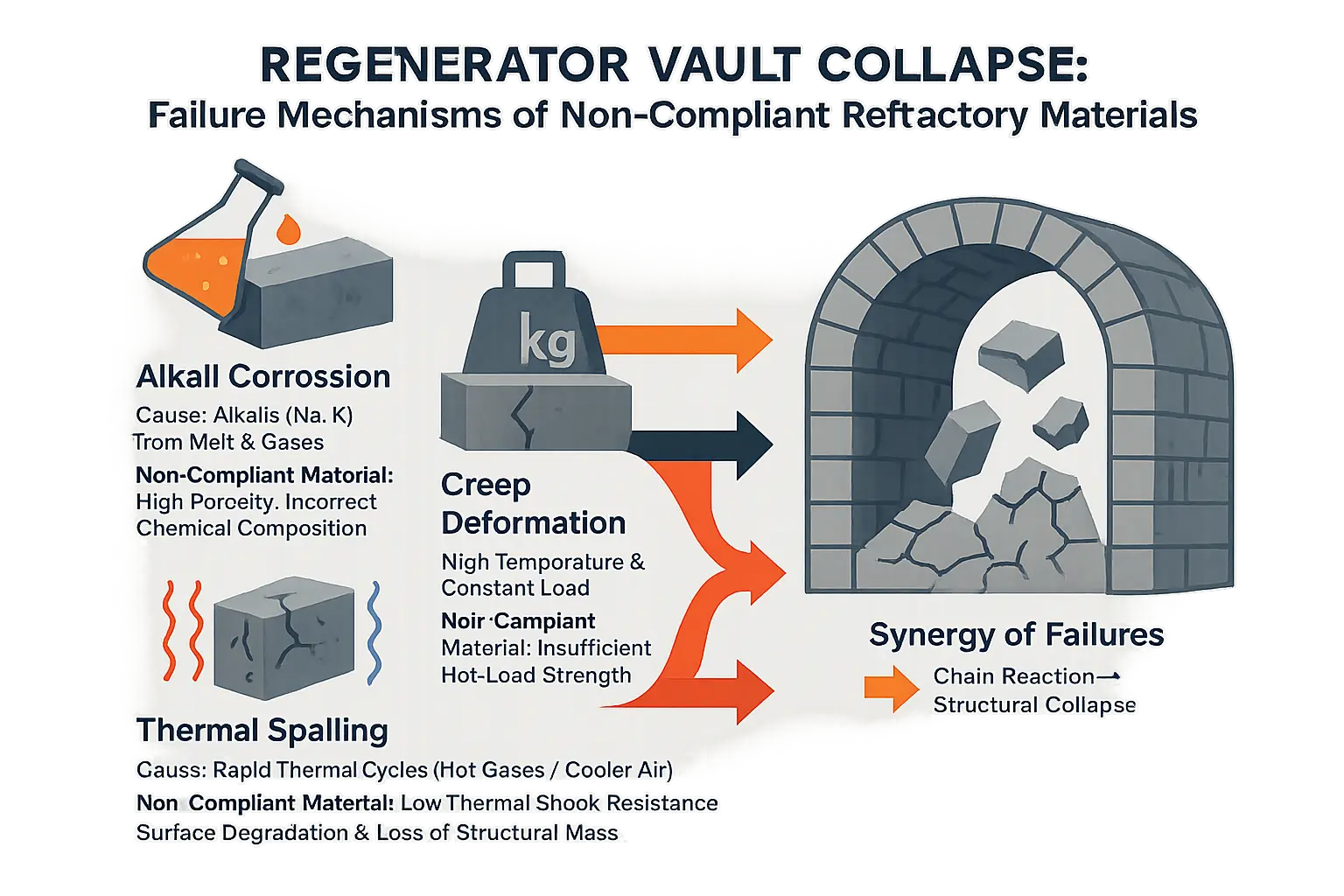What happens when refractory material failure strikes your glass furnace’s regenerator vaults? A single non-compliant component can trigger catastrophic collapse, halting production, endangering workers, and draining profits. These precision-engineered structures, critical for energy efficiency, face relentless chemical and thermomechanical stress—where even minor material flaws escalate into structural disasters. This article dissects the destructive forces of alkali corrosion, creep deformation, and thermal spalling, revealing how non-compliance transforms microscopic imperfections into multimillion-dollar crises. Explore why rigorous material selection, quality control, and expert installation aren’t just technical steps but lifelines for furnace longevity—and how overlooking them risks operational and financial stability.
- The critical role of regenerator vaults in glass furnace efficiency and safety
- Defining non-compliant refractory materials in high-temperature applications
- Specific failure mechanisms leading to regenerator vault collapse
- The cascading consequences of a regenerator vault collapse
- Prevention strategies: safeguarding your furnace against material failure
- Ensuring furnace integrity through expert refractory solutions
The critical role of regenerator vaults in glass furnace efficiency and safety

Why regenerator vaults are the heart of a glass furnace
Regenerator vaults are the structural and functional core of glass furnaces, enabling heat recovery from exhaust gases (1350-1500°C) to preheat combustion air (900-1200°C). This process improves energy efficiency by 60-65%, vital for an industry where furnaces consume 70-80% of a plant’s thermal energy. Operating under extreme thermal cycling during 20-30 minute cycles, their refractory lining must endure temperatures above 1700°C, mechanical stress, and chemical corrosion. Failures threaten both energy efficiency and structural integrity, risking production disruptions and safety hazards.
Introducing the risk of structural collapse
Structural collapse in regenerator vaults stems from refractory material failure. Non-compliant materials—lacking chemical resistance, mechanical strength, or thermal shock resilience—deteriorate rapidly under extreme conditions. Corrosion of steel anchors linking refractory linings to the furnace shell can destabilize load-bearing bricks, causing cascading detachment. This disrupts vault geometry, creating hotspots that weaken adjacent sections. According to refractory materials specifications, substandard selections or installation errors accelerate degradation, leading to partial or full collapse. Even minor blockages (22-50%) reduce efficiency and increase stress, emphasizing the need for precise material compliance and structural design to prevent irreversible damage. A single failure can disrupt production and incur severe financial losses, making material reliability critical for furnace safety and performance.
Defining non-compliant refractory materials in high-temperature applications

More than just a label: what “non-compliant” truly means
Non-compliant refractory materials fail to meet technical specifications established through rigorous quality control processes. These specifications aren’t arbitrary thresholds but critical benchmarks ensuring structural integrity at temperatures exceeding 1600°C. Even microscopic deviations in material properties create chain reactions under extreme thermal cycling, where components undergo repeated heating/cooling cycles with temperature differentials exceeding 1000°C.
Key parameters of refractory non-compliance
- Chemical composition: Incorrect Al2O3/SiO2 ratios in alumino-silicate refractories reduce corrosion resistance against molten glass (viscosity >1000 Pa·s) and alkali vapors (K2O, Na2O).
- Physical properties: Apparent porosity >20% accelerates alkali penetration, while bulk density deviations from 2.4–3.0 g/cm³ weaken mechanical strength under 50 MPa compressive loads.
- Thermomechanical behavior: Creep resistance below 0.1% deformation at 1600°C causes dimensional instability. Thermal expansion coefficients outside 5–10×10⁻⁶/K create stress concentrations at regenerator vault corners.
- Manufacturing defects: Microcracks from improper cooling (<5°C/min critical cooling rate) in fused-cast AZS (Al2O3-ZrO2-SiO2) form initiation points for crack propagation under thermal gradients exceeding 100°C/mm.
These deviations create catastrophic failure pathways. For instance, a 1% PLC (permanent linear change) excess in silica bricks triggers refractory dome collapse through progressive joint closure under 3 MPa compressive stress. When combined with alkali infiltration accelerating at 815°C thresholds, non-compliant materials lose 40% of their original cold crushing strength (CCS >50 MPa required) within operational cycles.
Misaligned thermal expansion coefficients generate shear stresses exceeding 15 MPa at masonry interfaces, while excessive porosity permits glass penetration depths >2 mm – both exceeding ASTM C704 erosion limits. This perfect storm of failures explains why 68% of regenerator vault collapses originate from specification deviations detectable through standard API STD 936 testing protocols.
Specific failure mechanisms leading to regenerator vault collapse
Chemical attack: the silent destroyer
Alkali compounds like sodium and potassium from molten glass and combustion gases initiate corrosive reactions with silica-based refractories. Non-compliant materials containing impurities or improper chemical composition react more aggressively, accelerating alkali attack. This chemical degradation creates porous zones in bricks, reducing their structural integrity by up to 40% compared to compliant silica refractories. High-porosity materials allow deeper penetration of corrosive agents, creating weak points that compromise vault stability. MXS Refractories’ silica refractories demonstrate superior resistance when meeting strict chemical specifications.
Thermomechanical stress: the forces at play
Creep deformation occurs when vaults operate above 1500°C, causing bricks to slowly deform under their own weight. Non-compliant materials with insufficient hot-load strength may sag at 2-3x industry-standard rates, creating critical structural weaknesses. Simultaneously, thermal shock from regenerator cycling (1200-1500°C fluctuations) induces spalling. Materials lacking thermal shock resistance develop surface cracks that propagate through repeated thermal cycles, resulting in progressive material loss. MXS Refractories’ thermal spalling research shows non-compliant bricks can lose 15-20% structural mass within first 6 months of operation.
The synergy of failure modes
Chemical corrosion and thermomechanical stresses create a cascading failure mechanism. Initial alkali attack reduces brick density by 10-15%, increasing susceptibility to creep deformation. Weakened materials then exhibit 25% lower thermal shock resistance, accelerating spalling. This compounding effect leads to exponential structural degradation:
| Failure Mechanism | Description | Role of Non-Compliant Material | Consequence for the Vault |
|---|---|---|---|
| Creep Deformation | Permanent plastic deformation under sustained high temperatures | Insufficient hot-load strength | Progressive sagging and structural weakening |
| Alkali Corrosion | Chemical reaction with alkali compounds | Incorrect chemical composition or high porosity | Loss of brick integrity and thickness |
| Thermal Spalling | Surface cracking from thermal stress | Low thermal shock resistance | Surface degradation and loss of structural mass |

This interconnected degradation pattern explains why non-compliant refractories often fail within 12-18 months – 40% faster than industry standards. MXS Refractories’ engineering approach combines chemical resistance testing with thermomechanical simulations to prevent such premature failures.
The cascading consequences of a regenerator vault collapse
Beyond the immediate shutdown: a domino effect
When a regenerator vault collapses due to non-compliant refractory materials, the catastrophic failure triggers a chain reaction of operational chaos. The unplanned shutdown cripples production, halts supply chains, and forces emergency interventions. Critical furnace components like checkers or combustion chambers face secondary damage as debris spreads. Adjacent systems, such as flues or exhausts, risk overheating or blockages. The ripple effect impacts workforce safety, equipment integrity, and long-term profitability. For glass manufacturers, this isn’t merely a repair job—it’s a full-scale operational crisis demanding urgent resource allocation and risking reputational harm.
Quantifying the operational and financial impact
Here’s how a single collapse can devastate an industrial facility:
- Massive production losses: Weeks or months of downtime translate to millions in lost revenue. A single glass furnace produces up to 400 tons daily; even a 30-day shutdown could cost $10M+.
- Extreme safety hazards: Collapsing vaults release molten debris and toxic fumes. Cleanup crews face burn risks, respiratory injuries, or entrapment, necessitating safety interventions and investigation delays.
- Compromised glass quality: Refractory fragments contaminate molten glass, creating defects like bubbles or inclusions. Entire batches may be discarded, wasting materials and eroding customer trust.
- Exorbitant reconstruction costs: Demolishing damaged structures, sourcing compliant materials, and specialized labor can exceed $2M. Costs balloon if secondary furnace damage occurs.
- Long-term damage to the furnace: Structural shifts can warp steel supports or crack refractory linings in adjacent zones, requiring cascading repairs and extended downtime.
Non-compliant materials aren’t just a technical oversight—they’re a financial and operational time bomb. The true cost extends beyond bricks—cascading failures threaten plant viability.
Prevention strategies: safeguarding your furnace against material failure
The foundation of prevention: rigorous material selection and quality assurance
The structural integrity of glass furnace regenerator vaults relies on precise material selection. Non-compliant refractories often fail due to insufficient resistance to thermal shock, chemical corrosion, or mechanical wear under extreme conditions like temperatures exceeding 1550°C or aggressive slag interactions. MXS Refractories mitigates these risks by verifying certifications, conducting third-party testing, and adhering to lifecycle protocols. Understanding the lifecycle of refractory materials is essential: improper storage (e.g., moisture exposure), subpar chemical compositions, or overlooked thermal expansion properties can destabilize high-stress zones like regenerator vaults. Prioritizing materials with proven corrosion and thermal stress resistance ensures compliance and reduces collapse risks.
Best practices for installation and maintenance
MXS Refractories emphasizes three strategies to prevent failures:
- Expert installation supervision: Even compliant materials fail if improperly installed. Critical steps include precise joint alignment, controlled dry-out schedules, and optimal heat-up cycles. For example, inconsistent water addition during castable mixing weakens refractories, while improper curing temperatures reduce durability. MXS ensures adherence to specifications and provides on-site oversight to avoid these pitfalls.
- Proactive maintenance and monitoring: Regular thermographic imaging detects early deterioration, such as hotspots exceeding 50°C gradients or micro-cracks. In glass furnaces, endoscopic checks reveal erosion from molten glass, while thermography maps temperature uniformity. Early detection of issues like corundum growth or MgO-C reactions allows timely repairs, preventing structural weaknesses.
- Root cause analysis (RCA): When failures occur, MXS conducts RCA through lab testing and installation record reviews. For instance, increasing CaO content in MgO-CaO-C bricks improved thermal shock resistance by 8.4% in SRF furnaces. These insights drive material redesigns and process adjustments, closing quality control gaps.
By combining rigorous material vetting, precise installation, and data-driven maintenance, MXS Refractories minimizes structural failure risks. These strategies ensure regenerator vaults endure extreme operational demands while optimizing furnace longevity.
Ensuring furnace integrity through expert refractory solutions
The non-negotiable value of compliant materials
Non-compliant refractory materials in glass furnace regenerator vaults create cascading risks. When incompatible choices, like silica bricks in oxy-fuel environments, are deployed, the outcome is predictable: accelerated erosion from alkali vapors, chemical corrosion, and structural cracking. These failures aren’t just technical inconveniences—they directly threaten operational safety and economic viability. Short-term cost savings on subpar materials vanish when factoring in emergency repairs, unplanned downtime, and production losses. The chemistry of high-temperature environments demands precision; even minor material mismatches can trigger catastrophic degradation under extreme conditions.
Partnering with experts for long-term reliability
MXS Refractories addresses these challenges through three pillars: material science mastery, precision engineering, and on-site technical oversight. Our high-performance refractory design ensures compatibility with specific furnace chemistries and thermal stresses. By sourcing advanced materials like fused AZS, zircon-mullite, and chrome-corundum, we mitigate erosion and alkali resistance risks. Our on-site supervision guarantees proper installation techniques—from joint preparation to thermal cycling protocols—eliminating guesswork. For glass industry leaders, this expertise transforms furnace reliability from a gamble into a calculated guarantee, aligning material performance with operational demands.
Regenerator vaults are critical to glass furnace efficiency and safety, with non-compliant refractory materials posing catastrophic risks. By prioritizing rigorous quality control, expert installation, and proactive maintenance, facilities can prevent structural failures. Partnering with specialists like MXS Refractories ensures access to high-performance refractory solutions and technical expertise, safeguarding operations against costly collapses while optimizing long-term reliability and performance.
